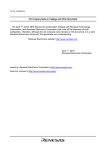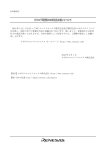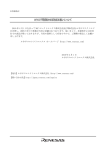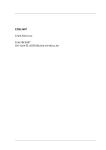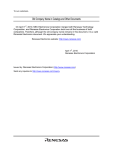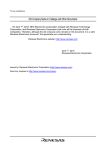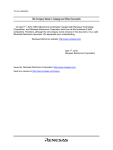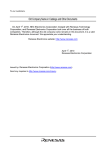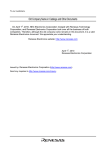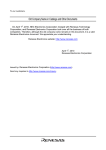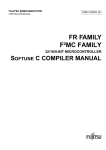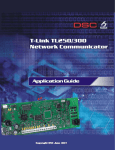Download SH7612 Evaluation Chip Board (HS7612EBK81H) for the E8000
Transcript
To our customers, Old Company Name in Catalogs and Other Documents On April 1st, 2010, NEC Electronics Corporation merged with Renesas Technology Corporation, and Renesas Electronics Corporation took over all the business of both companies. Therefore, although the old company name remains in this document, it is a valid Renesas Electronics document. We appreciate your understanding. Renesas Electronics website: http://www.renesas.com April 1st, 2010 Renesas Electronics Corporation Issued by: Renesas Electronics Corporation (http://www.renesas.com) Send any inquiries to http://www.renesas.com/inquiry. Notice 1. 2. 3. 4. 5. 6. 7. All information included in this document is current as of the date this document is issued. Such information, however, is subject to change without any prior notice. Before purchasing or using any Renesas Electronics products listed herein, please confirm the latest product information with a Renesas Electronics sales office. Also, please pay regular and careful attention to additional and different information to be disclosed by Renesas Electronics such as that disclosed through our website. Renesas Electronics does not assume any liability for infringement of patents, copyrights, or other intellectual property rights of third parties by or arising from the use of Renesas Electronics products or technical information described in this document. No license, express, implied or otherwise, is granted hereby under any patents, copyrights or other intellectual property rights of Renesas Electronics or others. You should not alter, modify, copy, or otherwise misappropriate any Renesas Electronics product, whether in whole or in part. Descriptions of circuits, software and other related information in this document are provided only to illustrate the operation of semiconductor products and application examples. You are fully responsible for the incorporation of these circuits, software, and information in the design of your equipment. Renesas Electronics assumes no responsibility for any losses incurred by you or third parties arising from the use of these circuits, software, or information. When exporting the products or technology described in this document, you should comply with the applicable export control laws and regulations and follow the procedures required by such laws and regulations. You should not use Renesas Electronics products or the technology described in this document for any purpose relating to military applications or use by the military, including but not limited to the development of weapons of mass destruction. Renesas Electronics products and technology may not be used for or incorporated into any products or systems whose manufacture, use, or sale is prohibited under any applicable domestic or foreign laws or regulations. Renesas Electronics has used reasonable care in preparing the information included in this document, but Renesas Electronics does not warrant that such information is error free. Renesas Electronics assumes no liability whatsoever for any damages incurred by you resulting from errors in or omissions from the information included herein. Renesas Electronics products are classified according to the following three quality grades: “Standard”, “High Quality”, and “Specific”. The recommended applications for each Renesas Electronics product depends on the product’s quality grade, as indicated below. You must check the quality grade of each Renesas Electronics product before using it in a particular application. You may not use any Renesas Electronics product for any application categorized as “Specific” without the prior written consent of Renesas Electronics. Further, you may not use any Renesas Electronics product for any application for which it is not intended without the prior written consent of Renesas Electronics. Renesas Electronics shall not be in any way liable for any damages or losses incurred by you or third parties arising from the use of any Renesas Electronics product for an application categorized as “Specific” or for which the product is not intended where you have failed to obtain the prior written consent of Renesas Electronics. The quality grade of each Renesas Electronics product is “Standard” unless otherwise expressly specified in a Renesas Electronics data sheets or data books, etc. “Standard”: 8. 9. 10. 11. 12. Computers; office equipment; communications equipment; test and measurement equipment; audio and visual equipment; home electronic appliances; machine tools; personal electronic equipment; and industrial robots. “High Quality”: Transportation equipment (automobiles, trains, ships, etc.); traffic control systems; anti-disaster systems; anticrime systems; safety equipment; and medical equipment not specifically designed for life support. “Specific”: Aircraft; aerospace equipment; submersible repeaters; nuclear reactor control systems; medical equipment or systems for life support (e.g. artificial life support devices or systems), surgical implantations, or healthcare intervention (e.g. excision, etc.), and any other applications or purposes that pose a direct threat to human life. You should use the Renesas Electronics products described in this document within the range specified by Renesas Electronics, especially with respect to the maximum rating, operating supply voltage range, movement power voltage range, heat radiation characteristics, installation and other product characteristics. Renesas Electronics shall have no liability for malfunctions or damages arising out of the use of Renesas Electronics products beyond such specified ranges. Although Renesas Electronics endeavors to improve the quality and reliability of its products, semiconductor products have specific characteristics such as the occurrence of failure at a certain rate and malfunctions under certain use conditions. Further, Renesas Electronics products are not subject to radiation resistance design. Please be sure to implement safety measures to guard them against the possibility of physical injury, and injury or damage caused by fire in the event of the failure of a Renesas Electronics product, such as safety design for hardware and software including but not limited to redundancy, fire control and malfunction prevention, appropriate treatment for aging degradation or any other appropriate measures. Because the evaluation of microcomputer software alone is very difficult, please evaluate the safety of the final products or system manufactured by you. Please contact a Renesas Electronics sales office for details as to environmental matters such as the environmental compatibility of each Renesas Electronics product. Please use Renesas Electronics products in compliance with all applicable laws and regulations that regulate the inclusion or use of controlled substances, including without limitation, the EU RoHS Directive. Renesas Electronics assumes no liability for damages or losses occurring as a result of your noncompliance with applicable laws and regulations. This document may not be reproduced or duplicated, in any form, in whole or in part, without prior written consent of Renesas Electronics. Please contact a Renesas Electronics sales office if you have any questions regarding the information contained in this document or Renesas Electronics products, or if you have any other inquiries. (Note 1) “Renesas Electronics” as used in this document means Renesas Electronics Corporation and also includes its majorityowned subsidiaries. (Note 2) “Renesas Electronics product(s)” means any product developed or manufactured by or for Renesas Electronics. To all our customers Regarding the change of names mentioned in the document, such as Hitachi Electric and Hitachi XX, to Renesas Technology Corp. The semiconductor operations of Mitsubishi Electric and Hitachi were transferred to Renesas Technology Corporation on April 1st 2003. These operations include microcomputer, logic, analog and discrete devices, and memory chips other than DRAMs (flash memory, SRAMs etc.) Accordingly, although Hitachi, Hitachi, Ltd., Hitachi Semiconductors, and other Hitachi brand names are mentioned in the document, these names have in fact all been changed to Renesas Technology Corp. Thank you for your understanding. Except for our corporate trademark, logo and corporate statement, no changes whatsoever have been made to the contents of the document, and these changes do not constitute any alteration to the contents of the document itself. Renesas Technology Home Page: http://www.renesas.com Renesas Technology Corp. Customer Support Dept. April 1, 2003 User’s Manual SH7612 Evaluation Chip Board (HS7612EBK81H) for the E8000 Emulator User’s Manual www.renesas-electoronics.com Notice When using this document, keep the following in mind: 1. This document may, wholly or partially, be subject to change without notice. 2. All rights are reserved: No one is permitted to reproduce or duplicate, in any form, the whole or part of this document without Hitachi’s permission. 3. Hitachi will not be held responsible for any damage to the user that may result from accidents or any other reasons during operation of the user’s unit according to this document. 4. Circuitry and other examples described herein are meant merely to indicate the characteristics and performance of Hitachi’s semiconductor products. Hitachi assumes no responsibility for any intellectual property claims or other problems that may result from applications based on the examples described herein. 5. No license is granted by implication or otherwise under any patents or other rights of any third party or Hitachi, Ltd. 6. MEDICAL APPLICATIONS: Hitachi’s products are not authorized for use in MEDICAL APPLICATIONS without the written consent of the appropriate officer of Hitachi’s sales company. Such use includes, but is not limited to, use in life support systems. Buyers of Hitachi’s products are requested to notify the relevant Hitachi sales office when planning to use the products in MEDICAL APPLICATIONS. Preface This manual describes how to connect and operate the EV-chip board. The EV-chip board incorporates an evaluation chip for connection to a user system that uses the SH7612 with the E8000 emulator. Read and understand Sec. 3, “Preparation before Use” of the E8000 Emulator User’s Manual before using this EV-chip board. CAUTION The EV-chip board is only for connection to a user system that uses the SH7612 with the E8000 emulator. It cannot be used for user systems that target other devices. Contents Section 1 1.1 1.2 EV-Chip Board Components ......................................................................................................... 1 Component Names ......................................................................................................................... 2 Section 2 2.1 Preparation before Use ......................................................................4 Preparing the User System............................................................................................................ 4 2.1.1 Recommended Mounting Pad Dimensions of the User System............................... 8 2.1.2 Connector Position on the User System...................................................................... 9 Section 3 3.1 Components ......................................................................................1 Connecting the EV-Chip Board to the User System............................12 Connecting the EV-Chip Board to the User System.................................................................. 12 3.1.1 Connecting the Specified Connector............................................................................ 12 3.1.2 Connecting the Trace Cables to the EV-Chip Board .................................................. 13 3.1.3 Connecting the EV-Chip Board to the User System Board ....................................... 13 Figures Figure 1.1 Figure 2.1 Figure 2.2 Figure 2.3 Figure 3.1 Figure 3.2 EV-Chip Board..................................................................................................................... 2 Recommended Mounting Pad Dimensions .................................................................... 8 Connector Position on the User System (Top View) .................................................... 10 Component Height Restriction......................................................................................... 8 Connecting Trace Cables to the EV-Chip Board............................................................ 15 Connecting the EV-Chip Board to the User System...................................................... 17 Tables Table 1.1 Table 2.1 Table 2.1 EV-chip Board Components.............................................................................................. 1 Pin Assignment of the HS7612EBK81H User Interface (USR1) .................................. 5 Pin Assignment of the HS7612EBK81H User Interface (USR2) .................................. 7 Section 1 Components 1.1 EV-Chip Board Components Table 1.1 lists the product components of the EV-chip board (HS7612EBK81H: 2 x 100-pin connector type). Check all the components after unpacking. Table 1.1 EV-chip Board Components Item Quantity Remarks EV-chip board (HS7612EBK81H) 1 Consists of two boards. • HS7410PWB20H (for connecting to the E8000 station) • HS7420PWB50H (2 x 100-pin connector) Note: Use the specific connector (FX2-100P-1.27SVL manufactured by HIROSE ELECTRIC CO., LTD.) on the user system that is connected to the HS7612EBK81H. 1 1.2 Component Names The component names of the EV-chip board are described below. Figure 1.1 EV-Chip Board 1. Station to EV-chip board interface connector CN3: For trace cable 3 which connects the E8000 station to the EV-chip board. 2. Station to EV-chip board interface connector CN2: For trace cable 2 which connects the E8000 station to the EV-chip board. 3. Station to EV-chip board interface connector CN1: For trace cable 1 which connects the E8000 station to the EV-chip board. 4. Crystal oscillator terminals: For installing a crystal oscillator to be used as a clock source for the SH7612. 5. User-system connector: For connecting the user system. 6. Board connector: For connecting HS7410PWB20H and HS7420PWB50H. 7. HS7410PWB20H: Includes connectors for interfacing with the E8000 station via trace cables. 2 8. HS7420PWB50H: Includes connectors for interfacing with the user system. 3 Section 2 Preparation before Use 2.1 Preparing the User System Table 2.1 lists the user interface pin assignment of the specific connector (FX2-100P-1.27SVL manufactured by HIROSE ELECTRIC CO., LTD.) when the target MCU is the SH7612. 4 Table 2.1 Pin Assignment of the HS7612EBK81H User Interface (USR1) Pin No. Pin Name Pin No. Pin Name Pin No. Pin Name 1 GND 35 GND 69 GND 2 GND 36 SRS0/PA1 70 DREQ0 3 CAS3 37 SRS1/PA0 71 MD0 4 CAS2 38 GND 72 GND 5 GND 39 RXD1/PB13 73 MD3 6 BS 40 TXD1/PB12 74 MD4 7 RDWR 41 GND 75 GND 8 GND 42 TXD0/PB9 76 SRXD2/PA15 9 CS1 43 SCK0 77 SRCK2/PA14 10 CS0 44 GND 78 GND 11 GND 45 FTI2/PB6 79 STCK2/PA11 12 WE3 46 FTC1/PB5 80 STS2/PA10 13 WE2 47 GND 81 GND 14 GND 48 FTC0/PB2 82 SRS1/PA7 15 BACK 49 FTOA0/PB1 83 STXD1/PA6 16 BREQ 50 GND 84 GND 17 GND 51 Not connected 85 SRXD0/PA3 18 DACK0 52 UVCC 86 SRCK0/PA2 19 DREQ1 53 Not connected 87 GND 20 GND 54 GND 88 STCK0/PB15 21 MD1 55 CAS1 89 STS0/PB14 22 MD2 56 CAS0 90 GND 23 GND 57 GND 91 SCK1/PB11 24 MD5 58 CS3 92 RXD0/PB10 25 Not connected 59 CS2 93 GND 26 GND 60 GND 94 FTC2/PB8 27 SRS2/PA13 61 WAIT 95 FTOA2/PB7 28 STXD2/PA12 62 RD 96 GND 29 GND 63 GND 97 FTOA1/PB4 30 SRXD1/PA9 64 WE1 98 FTUSR1/PB3 31 SRCK1/PA8 65 WE0 99 GND 32 GND 66 GND 100 FTI0/PB0 33 STCK1/PA5 67 IVECF 34 STS1/PA4 68 DACK1 5 6 Table 2.2 Pin Assignment of the HS7612EBK81H User Interface (USR2) Pin No. Pin Name Pin No. Pin Name Pin No. Pin Name 1 GND 35 GND 69 GND 2 A1 36 D22 70 EXTAL 3 A3 37 D20 71 GND 4 A4 38 D19 72 TRST 5 A6 39 D17 73 GND 6 GND 40 GND 74 CLK 7 A9 41 D14 75 GND 8 A11 42 D12 76 RST 9 A12 43 D11 77 GND 10 A14 44 D9 78 IRQ1 11 GND 45 GND 79 GND 12 A17 46 D6 80 IRQ3 13 A19 47 D4 81 D31 14 A20 48 D3 82 D29 15 A22 49 D1 83 GND 16 GND 50 GND 84 D26 17 Not connected 51 GND 85 D24 18 GND 52 A0 86 D23 19 Not connected 53 A2 87 D21 20 GND 54 GND 88 GND 21 Not connected 55 A5 89 D18 22 GND 56 A7 90 D16 23 Not connected 57 A8 91 D15 24 GND 58 A10 92 D13 25 NMI 59 GND 93 GND 26 GND 60 A13 94 D10 27 IRQ0 61 A15 95 D8 28 GND 62 A16 96 D7 29 IRQ2 63 A18 97 D5 30 GND 64 GND 98 GND 31 D30 65 A21 99 D2 100 D0 32 D28 66 A23 33 D27 67 GND 34 D25 68 Not connected 7 2.1.1 Recommended Mounting Pad Dimensions of the User System Figure 2.1 shows the dimensions of the recommended mounting pad (footprint) and positioning holes for the specific connector (FX2-100P-1.27SVL) manufactured by HIROSE ELECTRIC CO., LTD. The dimension tolerance is ±0.1 mm unless otherwise specified. Figure 2.1 Recommended Mounting Pad Dimensions 8 2.1.2 Connector Position on the User System CAUTION Before connecting the connectors (FX2-100P-1.27SVL) to the user system, check the location of pin 1 and the connector shapes as shown in figures 2.1 and 2.2. If the connector direction is incorrect, the EV-chip board cannot be connected to the user system. Figure 2.2 shows the direction of the connectors (FX2-100P-1.27SVL) on the user system. Comply with the user system component height restriction shown in Figure 2.3 within the external frame of the EV-chip board shown in Figure 2.2. 9 115.0 1 50 USR1 51 3.1 62.23±0.10 66.5 50 USR2 51 23.5 100 1 3.3 43.0 90.0 100 11.0 71.95±0.10 14.0 22.0 57.5 Center line External frame of the EV-chip board Unit: mm Tolerance: +0.1 mm Figure 2.2 Connector Position on the User System (Top View) 10 10.7 HS7420PWB50H User system socket FX2-100P-1.27SVL manufactured by HIROSE ELECTRIC CO., LTD User system board Unit: mm Figure 2.3 Component Height Restriction 11 Section 3 Connecting the EV-Chip Board to the User System 3.1 Connecting the EV-Chip Board to the User System 3.1.1 Connecting the Specified Connector This EV-chip board is designed exclusively for the specific connector (type number: FX2-100P1.27SVL) manufactured by HIROSE ELECTRIC CO., LTD. Therefore, it cannot be used with other connectors. • Positioning the IC socket The connector FX2-100P-1.27SVL has two positioning pins. Insert the positioning pins of the connector into the positioning holes of the user system board. Apply an epoxy adhesive to the tips of the positioning pins of the connector to bond the connector to the user system board. CAUTION Before connecting the connectors to the user system, check the location of pin 1 on both sides and the connector shapes (USR1 and USR2). • Mounting the connectors Solder the FX2-100P-1.27SVL onto the user system. Use more solder than usual so that a fillet is formed on the lead edge being soldered. 12 3.1.2 Connecting the Trace Cables to the EV-Chip Board Always switch OFF the emulator and user system before connecting or disconnecting any CABLES or sockets. Failure to do so will result in a FIRE HAZARD and will damage the user system and the emulator or will result in PERSONAL INJURY. The USER PROGRAM will be LOST. • EV-chip board condition at shipment The EV-chip board is shipped with the HS7410PWB20H and HS7420PWB50H connected to each other. When connecting the EV-chip board to the user system, do not separate the HS7410PWB20H from the HS7420PWB50H. CAUTION Before connecting the EV-chip board to the user system, confirm that the HS7410PWB20H and HS7420PWB50H are firmly connected by lightly pushing the board. • Connecting the trace cables to the E8000 station Before connecting the trace cables to the HS7410PWB20H, connect the trace cables to the E8000 station. Note: At shipment, trace cables CN2 and CN3 to be connected to the E8000 station are bound into a bundle, and trace cables CN1, CN2, and CN3 to be connected to the EV-chip board are bound into a bundle to prevent an insertion error. For more information on connecting the EV-Chip board to the E8000 station, refer to section 3.2.2, Connecting the EV-Chip Board, in the SH7612 E8000 Emulator User’s Manual. 13 • Connecting the trace cables to the EV-chip board Align the trace cables with the station to EV-chip board interface connectors CN1, CN2, and CN3 on the EV-chip board. Confirm that each trace cable connected to a connector on the E8000 station is also connected to its corresponding station to EV-chip board interface connector on the EV-chip board. For the prevention of insertion errors, colors are specified on the trace cable connectors and the corresponding EV-chip board interface connectors (CN1: red, CN2: yellow, CN3: blue). CAUTION For the prevention of insertion errors, colors are specified on the trace cable connectors and the corresponding EV-chip board interface connectors. 14 Tighten the screws to connect the trace cable connectors to the station to EV-chip board interface connectors while holding the HS7420PWB50H securely. Figure 3.1 Connecting Trace Cables to the EV-Chip Board Make sure the connector shapes and numbers are correctly matched when connecting the trace cables to the station to EV-chip board interface connectors. Failure to do so will result in a FIRE HAZARD. 15 3.1.3 Connecting the EV-Chip Board to the User System Board • Connecting the EV-chip board to the user system board Check the location of the FX2-100P-1.27SVL on the user system. Align the connectors on the HS7420PWB50H of the EV-chip board with those on the user system board, and insert the connectors. CAUTION Forcefully connecting the EV-chip board will apply stress to the soldered connectors on the user system, causing cracks in the solder. Gradually push the EV-chip board repeatedly so that no cracks occur in the soldered section of the connectors. 16 Figure 3.2 Connecting the EV-Chip Board to the User System 17
























